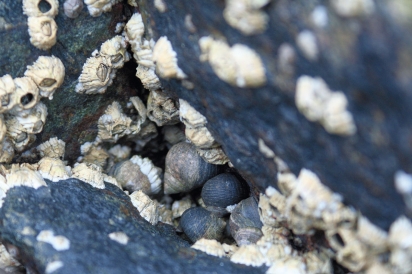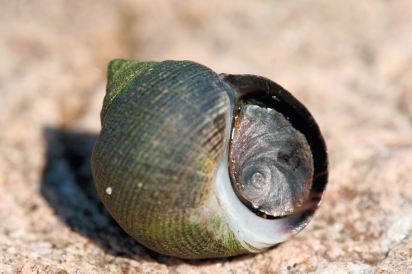Periwinkles: Tiny, tasty (and free!) tidal treats
Did you know that you can eat periwinkles? I didn’t until assigned to write this article. When I bring periwinkles up in conversation most people are ignorant of their culinary potential—and happy to remain so. “Ugh, the whole snail thing: too much for me,” and, “Hard to get motivated for a periwinkle,” were two typical responses. But periwinkles have the triple endorsement of being tasty, local, and free. Why not give them a try?
The common periwinkle, Littorina littorea, is a small intertidal snail whose shell ranges from tiny to about three-quarters of an inch wide. Pluck one off the rocks at the beach and the animal immediately retracts its body and closes itself within its shell. Periwinkles have a thin hard semi-circular “door” called an operculum attached to the side of their soft foot; they shut this upon themselves to guard against predation and desiccation at low tide. But if you hold the shell upside down, after a few seconds the operculum is pushed aside and the periwinkle’s “foot” and “head” with its two antennae will emerge and feel around for something to latch onto.
Cooking periwinkles is simple. Just throw them in boiling water with a little salt for about seven minutes, drain, and remove the meat by stabbing with a toothpick or pin and pulling gently. Through tiny, the body is surprisingly long, ending in a curling tail that is usually coiled around the upper spiral of the shell. Once cooked the periwinkle’s operculum will easily detach from the body and resembles a flake of mica. you can dip the meat in garlic butter or just eat it plain. The taste is similar to a steamer but with a more inviting texture. I quite enjoy them.
The major drawback to periwinkles is that they’re labor intensive. Even when motivated by having to write about them I was daunted at the idea of harvesting and plucking the meat from 4.5 cups of periwinkles, the amount required for the recipe for periwinkle fritters from foraging guru Euell Gibbons’ book Stalking the Blue-Eyed Scallop. I tended to just supplement my regular shellfish dishes with a couple of periwinkles thrown in, say in a seafood tomato sauce or mussels in a Thai broth (for that recipe the mussels are roasted at 500 degrees in the oven; that worked fine for the periwinkles which I cooked for six minutes instead of the full ten).
Periwinkles, though common on the Cape, are not found in the overwhelming abundance they are in the mid-coast Maine area. My mother-in-law, Katrine, and her husband Howard have a house on PenobscotBay in Maine and there I easily gathered 4.5 cups from the tidal flats. Just lifting up one patch of seaweed next to a tidal rock would reveal dozens snuggled together in the mud. But when I came up to the house with my pot full of periwinkles and announced that we would be having periwinkle fritters for dinner, Howard informed me there was a shell fishing ban in the area and they all got tossed back. (your town’s Department of natural resources will have information about shellfish closures due to bacterial or other health concerns. An official with the Massachusetts Department of Public Health said he’d never heard of anyone getting sick from eating a periwinkle and that they are less likely to accumulate toxins in their bodies than filter-feeding bivalves like mussels. you do not need a permit to harvest periwinkles.)
Howard and Katrine both grew up in the UK where periwinkles—or “winkles” as they’re known—are commonly sold in fish shops and seaside towns. Howard has memories of going “winkling” as a child and Katrine said she’d buy a newspaper cone full of them at the fish and chips shop where they were usually served sprinkled with vinegar.
They explained that periwinkles were considered “a sort of workingclass snack”, with most of the winkle shops in London being concentrated in the poorer East End. Periwinkles are also commonly eaten in Spain and Portugal. I’d heard that due to the area’s strong
Portuguese roots, periwinkles were sold at the Shaw’s in Fall river. When I called to fact check that, Kevin in the fish department said, “Absolutely, we always have them.” They were selling for $1.99 per pound. I mentioned that I’d never encountered periwinkles for sale. “really? That’s weird.” he said. “I see them all the time.” Periwinkles are actually native to Europe. They first appeared on this side of the Atlantic in nova Scotia in 1840, probably brought attached to rocks used for ships’ ballast. From there they spread southward, reaching Cape Cod in the 1870s. These little snails have had a significant impact on the coastline, according to Mark Bertness, a professor of coastal ecology at BrownUniversity. Bertness conducted a study where he removed the periwinkles from a section of rocky tidal beach in narragansett Bay and covered the snail-free area with cages to keep the animals out. The habitat in the snail-free zones changed substantially.
“Basically we took a rocky beach,” Bertness explained in a phone interview, “removed this invasive species, and in a couple months turned it into a muddy beach.” Periwinkles eat algae and as they do they also bulldoze sediments off the rocks they’re grazing on; this changes the beaches they inhabit from so called “soft-bottom” environments that are conducive to marsh grass growth to “hardbottom” or rocky beaches. Periwinkles also eat baby marsh grass I asked Bertness if he thought periwinkles on our shores was a good thing or a bad thing.
“I’m a scientist, not a philosopher,” he said. “This is not necessarily right or wrong, good or bad, but we have to think about these things.” Periwinkles, he said, have significantly decreased the amount of fringing salt marsh along the New England coast, which deliver a lot of ecosystem services like buffering the shoreline from storm damage and cleaning the water column.
A final note on periwinkles is that they make excellent crab bait. I was recently introduced to fishing for crabs using a periwinkle tied on the end of a blade of beach grass. You have to smash the periwinkle with a rock to get the meat out and then make sure you tie the meat tightly otherwise the crabs just slips it free. But if you bait a blade of grass and lower it between the rocks of a jetty it won’t be long until a crab comes out and from hiding and latches on. It was the eight-yearold daughter of a friend who showed me how to do this. She was explaining each step to me, and then, just before crushing the shell with the rock, she paused. “Thank you little periwinkle,” she said to the snail. Turning to me, she said, “you always have to thank the periwinkle: that’s very important.”







